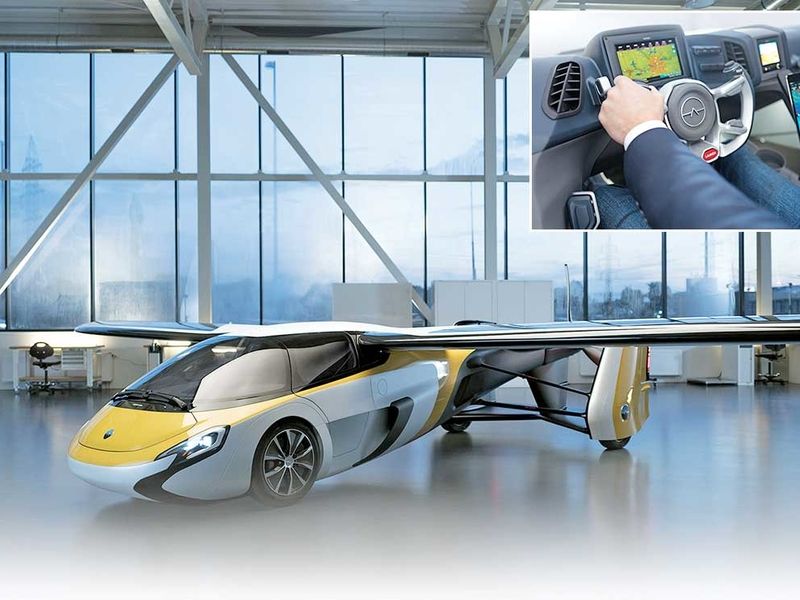
Flying cars may never revolutionize transportation. But for those few people who have the financial wherewithal and piloting skills to own and operate them, flying cars may indeed be revolutionary machines.
Forget the technological novelty of melding aviation and automotive. The practical achievement of creating a vehicle that can travel both on roadways and via airways might eradicate the everyday hassles associated with modern travel. No more long lines at security screenings or rental-car counters.
No rides in the back seats of heavy-scented Ubers.
Skip the soulless airport entirely, in fact, should the mood strike.
“A plane that you can take on the road changes everything,” said Robert Dingemanse, co-founder and CEO of Dutch flying-car company PAL-V. “General aviation is cumbersome, because once you land, you’re stuck at an airport. This way, you take it from your garage, fly somewhere and after landing you don’t leave your plane or store it. You just drive it to your destination.”
Flying cars have stretched the imagination for the better part of a century. Inventors and tinkerers have produced concepts that achieved liftoff and trundled along roads for a while. But they’ve stalled in transforming their creations from one-off science projects into mature commercial products.
A combination of new lightweight materials and regulatory tailwinds now allow for that possibility.
In February, the European Union Aviation Safety Agency granted a first-of-its-kind certification to PAL-V’s Liberty, a two-seat gyroplane that met approximately 1,500 requirements to earn its new status after more than a decade of development. Last fall, the company received a road-ready thumbs-up from Europe’s ground-based regulators. Dingemanse aims to sell 90 of the aircraft.
Competitors may be in pursuit. The Terrafugia Transition, a flying car made by a Zhejiang Geely Holding Group subsidiary, received its Special Light-Sport Aircraft airworthiness certificate from the U.S. Federal Aviation Administration in January. Other startups undertaking flying-car development include Slovakia-based AeroMobil and California’s NFT Inc., which makes the Aska Drive & Fly.
Flying-car companies may have captured interest, but so far they have not seen the same level of enthusiasm from Wall Street or venture capitalists as other startups in the aviation realm. A double dose of regulations — aviation and automotive — and a niche market are sticking points. Currently, the PAL-V is slated to retail for $600,000. Aska says its first craft will cost $789,000. When AeroMobil unveiled its flying car in 2017, it estimated models would cost $1.3 million to $1.6 million each.
Asad Hussain, senior analyst at Pitchbook, says despite their technical feasibility, flying cars remain a somewhat fanciful pursuit.
“There’s a whole other layer of complexity in having a vehicle that’s crashworthy on roads and light enough to take off from a road,” he said.
“It’s going to be such an uphill battle to get regulators on board. It’s going to take years and years and years. Maybe in China they can make it work.”
In a move that reflects perhaps both the promise and uncertainty involved, Geely shuttered Terrafugia’s U.S. operations and shifted development to China just weeks after securing the Transition’s airworthiness certificate. Kevin Colburn, general manager of Terrafugia, says the company no longer plans to pursue launching the flying car in the U.S., and plans for China are uncertain.
For PAL-V, founded in 2008, there’s a clear runway. Dingemanse says there’s more testing and regulatory work ahead, but the company is on track to deliver the Liberty to customers in late 2022. PAL-V’s supply chain includes purchasing body composite parts from a Mitsubishi division in Germany that provides similar parts to Porsche and Lamborghini.
He’s perplexed by some of the skepticism surrounding flying cars. The Liberty, he said, was designed to work without the need for vehicle technology advances, within existing government regulations and with no further needed infrastructure. It’s far different, he scoffed, from the likes of air taxis and electric takeoff-and-landing (eVTOL) aircraft, which require new regulatory handbooks, perhaps new airspace management rules and new vertiports for urban operations.
Dingemanse also underlined a more fundamental difference: While there can be some similarities among all three, he says only flying cars will provide true door-to-door service, thus enabling truly seamless transportation.
Air taxis and eVTOLs are largely expected to drop off and pick up passengers at hubs.
“People think eVTOLs compete with flying cars, but they really don’t,” he said. “A flying car is something which you own, which you can take from any door to another with more fun, functionality and efficiency. The world is open.”
The flying car, delivering the ultimate in personal mobility convenience.